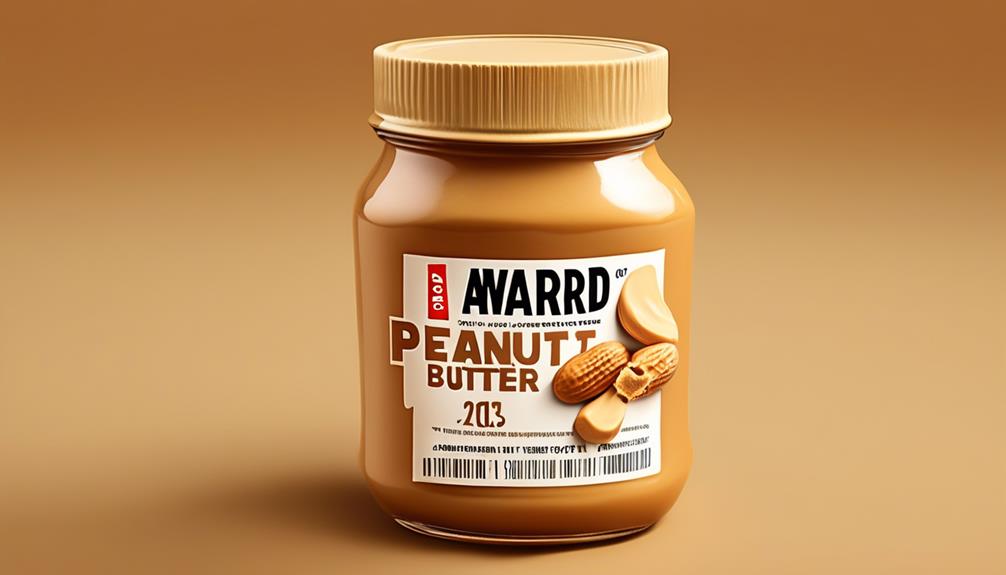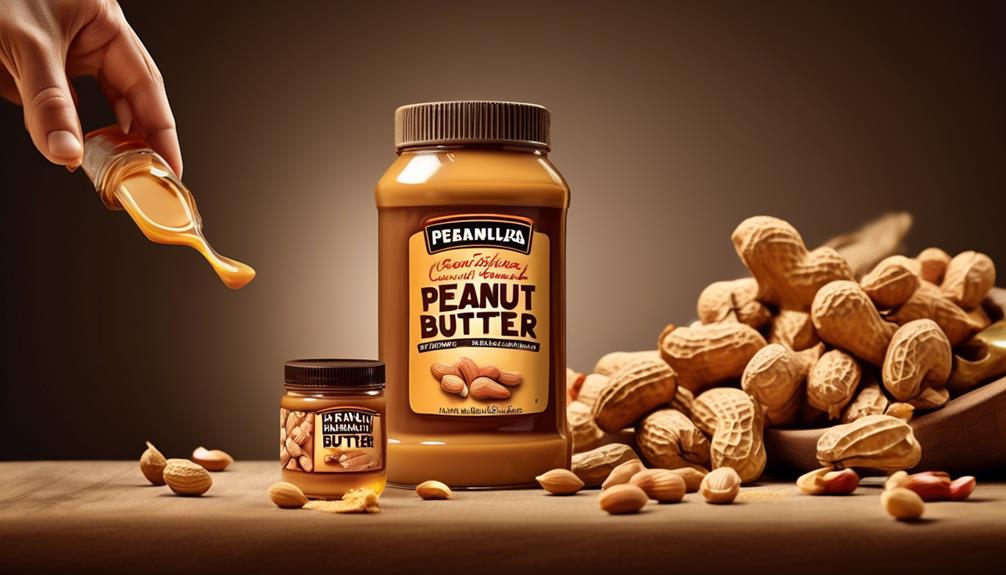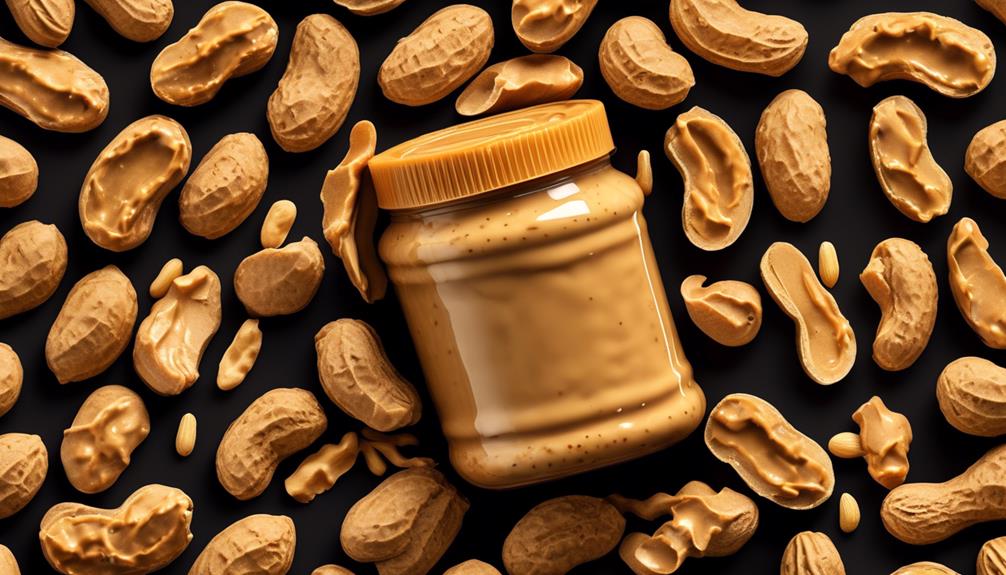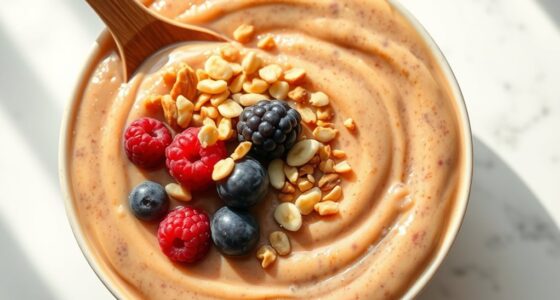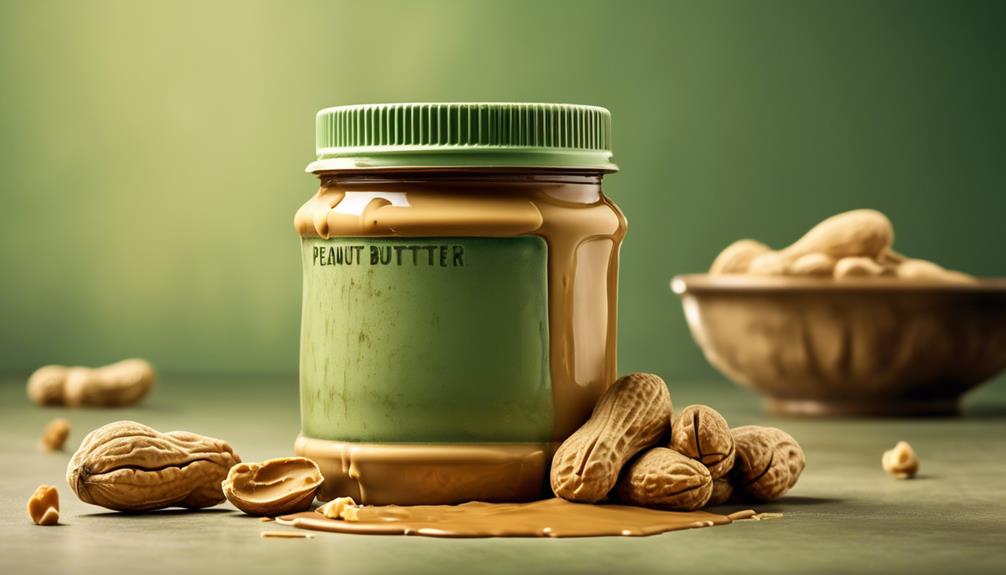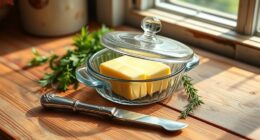Have you ever thought about whether it’s possible to make your own rich, delicious peanut butter at home? You may be surprised to find out that it is. By using just a few basic ingredients and putting in minimal effort, you can not only make homemade peanut butter, but also find the process incredibly rewarding.
But before we delve into the specifics of this process, let's consider the advantages of crafting your own peanut butter from scratch.
Key Takeaways
- Making homemade peanut butter is easy and satisfying, requiring minimal effort.
- Homemade peanut butter allows for customization of flavors and ingredients, giving you control over the taste and nutritional content.
- Selecting the right peanuts is crucial for achieving the desired flavor and texture in homemade peanut butter.
- Storing homemade peanut butter properly, in an airtight container and refrigerated, helps maintain its freshness and extend its shelf life.
Equipment Needed
We will need a food processor or a high-speed blender to effectively make homemade peanut butter. These machines are essential for grinding the peanuts into a smooth and creamy peanut butter.
To begin, add the peanuts to the food processor or blender and use the machine's powerful blades to break them down. The high-speed motor will crush the peanuts, releasing their natural oils and creating a smooth, creamy texture. The food processor's sharp blades and powerful motor make it ideal for this task.
As the peanuts are ground down, they'll transform into a thick and creamy peanut butter. The food processor's design allows for easy scraping down the sides, ensuring that all the peanuts are evenly processed. Once the peanuts have reached the desired consistency, transfer the homemade peanut butter to an airtight container for storage.
The food processor simplifies the process of making homemade peanut butter, resulting in a delicious and satisfying spread for all your culinary creations.
Selecting the Right Peanuts

When selecting the right peanuts for homemade peanut butter, it's essential to consider the variety options available.
We can choose from a range of peanut types, including Valencia, Virginia, and Spanish, each offering unique characteristics in terms of flavor and oil content.
Additionally, we should prioritize the quality and freshness of the peanuts, aiming for those with a rich aroma and without any signs of mold or rancidity.
Lastly, we may want to explore the choice between organic and conventional peanuts, taking into account factors such as farming practices and potential pesticide residues.
Peanut Variety Options
Selecting the right peanuts for homemade peanut butter involves considering factors such as dry roasting for enhanced flavor and experimenting with different nut varieties to create unique butter variations.
Dry roasted peanuts are a popular choice for homemade peanut butter due to their rich flavor and smoother texture.
When experimenting with nut varieties, almonds, cashews, and hazelnuts can be used to create natural peanut butter or smooth nut butter with distinct flavors.
For those who prefer a crunchy texture, incorporating a portion of processed peanuts back into the smooth peanut butter can provide a delightful contrast.
Additionally, roasting raw peanuts in the oven at 350°F for about 10 minutes before processing enhances the flavor and ensures easier blending.
Whether opting for unsalted peanuts or honey-roasted peanuts, the peanut variety chosen will significantly impact the final homemade peanut butter recipe.
Quality and Freshness
For optimal quality and freshness when selecting peanuts for homemade peanut butter, carefully inspect the peanuts for any signs of staleness or rancidity and opt for dry roasted, unsalted peanuts from a trusted source. Consider purchasing organic peanuts to avoid potential exposure to pesticides or chemicals. It's essential to ensure the peanuts have a fresh, nutty aroma by smelling them before use, indicating their quality and freshness. Below is a table summarizing the key points to consider when selecting peanuts for homemade peanut butter:
| Key Points | Details |
|---|---|
| Peanut Type | Dry roasted, unsalted peanuts |
| Source | Trusted and preferably organic |
| Signs of Freshness | Nutty aroma, no staleness or rancidity |
| Potential Exposure to Harmful Chemicals | Consider organic peanuts to avoid pesticides or chemicals |
When selecting peanuts, these factors contribute to the overall quality and freshness of the homemade peanut butter, resulting in a delicious and wholesome spread.
Organic Vs Conventional
Comparing the cultivation methods of organic and conventional peanuts reveals significant differences in the use of synthetic chemicals and sustainable farming practices. When making homemade peanut butter, it's crucial to consider the source of the peanuts. Here's why organic peanuts are the better choice:
- Organic peanuts are grown without synthetic pesticides or fertilizers, reducing the risk of chemical residues in your peanut butter.
- Choosing organic peanuts supports sustainable farming practices, promoting soil health and biodiversity.
- Organic peanuts are non-GMO and grown using natural fertilizers and crop rotation, making them a healthier option for you and the environment.
Roasting the Peanuts

After preheating the oven to 350°F (177°C), the peanuts should be roasted for about 10 minutes until they achieve a golden brown color. This process is crucial as it enhances the natural oils and deepens the nutty flavor of the peanuts.
Once the roasting is complete, it's important to remove the peanuts from the oven and allow them to cool for about 10 minutes. This cooling period not only makes the peanuts easier to handle but also prevents them from becoming too hot during the processing phase.
After cooling, transfer the peanuts to the bowl of a food processor. The beauty of dry roasted peanuts is that they grind into a smooth, creamy consistency effortlessly. The result is a rich and aromatic peanut flavor that's unparalleled.
To further enhance the taste, a teaspoon of salt can be added at this stage. This step is fundamental in creating a perfectly balanced homemade peanut butter.
Once the peanuts are finely ground, they can be processed in a high-powered blender to achieve the desired smoothness and creaminess.
Processing the Peanuts

Using a food processor, begin by adding the dry roasted peanuts and processing until they form a smooth, creamy consistency, pausing periodically to scrape down the sides. Initially, the peanuts will be chunky, then form a shaggy ball, and finally blend into creamy peanut butter. Stop the food processor every 30 seconds to 1 minute to cool off the motor and scrape down the sides. Adjust the amount of peanuts based on the size of your food processor.
When making nut butters, it's crucial to pay attention to the texture changes during processing. The peanuts will go through various stages, from initial coarseness to a shaggy ball before finally transforming into a smooth and creamy consistency. This process requires patience and regular monitoring to achieve the desired results.
It's important to consider the capacity of your food processor. For smaller processors, it's best to process the peanuts in smaller batches to ensure they blend evenly and achieve the desired creamy texture. This step ensures that the motor isn't overworked and that the peanuts are processed uniformly, resulting in a perfectly smooth homemade peanut butter.
Flavoring and Seasoning

When flavoring and seasoning homemade peanut butter, incorporating various ingredients such as honey, agave, maple syrup, or sugar allows for customizable taste profiles. Additionally, adding a pinch of salt can help balance and enhance the overall flavor according to personal preferences. Experimenting with spices like cinnamon, cardamom, ginger, or nutmeg can add depth and complexity to the nutty taste, while incorporating ingredients like espresso powder for a coffee flavor, cocoa powder for a chocolatey twist, or chiles for a spicy kick can create unique and flavorful variations of peanut butter. For those who enjoy a different nutty taste, adding almond butter can also provide an interesting flavor dimension. Below is a table summarizing some flavoring and seasoning options for homemade peanut butter:
| Flavoring/Seasoning | Description | Usage |
|---|---|---|
| Maple Syrup | Adds a hint of sweetness | Making homemade peanut butter, peanut sauce |
| Cocoa Powder | Provides a chocolatey twist | Peanut butter cookies, making homemade peanut butter |
| Honey | Adds a touch of sweetness | Making homemade peanut butter, peanut butter cookies |
Storing the flavored and seasoned peanut butter in an airtight container at room temperature for up to 6 months ensures freshness and delicious taste.
Storing Homemade Peanut Butter

To ensure the optimal shelf life and maintain the quality of homemade peanut butter, it's essential to store it in a cool, dry place away from direct sunlight and heat sources. Storing homemade peanut butter properly is crucial to prevent spoilage and maintain its freshness. Here are some key tips to consider:
- Airtight Container: Transfer the homemade peanut butter to an airtight container to protect it from exposure to air, which can cause it to become rancid.
- Refrigeration: While not necessary, refrigerating homemade peanut butter can extend its shelf life and help maintain its texture. However, if you plan to use it frequently, storing it at room temperature is acceptable.
- Avoid Moisture: Keep the peanut butter away from moisture to prevent mold growth and maintain its creamy consistency.
Using Homemade Peanut Butter

We blend homemade peanut butter with banana and honey for a nutritious and delicious spread. Using homemade peanut butter opens up a world of culinary possibilities. The creaminess and freshness of homemade peanut butter elevate the flavors of any dish. Here's a simple recipe for making your own peanut butter at home using a food processor:
| Ingredients | Instructions | Tips |
|---|---|---|
| Peanuts | Roast raw peanuts in the oven until golden brown. Let them cool before using. | Use unsalted peanuts for a healthier option. |
| High-speed blender or food processor | Add the roasted peanuts to the blender or food processor. Blend on high speed until the peanuts turn into a smooth, creamy consistency. | Stop and scrape down the sides of the blender or food processor as needed to ensure even blending. |
| Salt (optional) | Add a pinch of salt for flavor, if desired. | Taste the peanut butter and adjust the salt to your preference. |
Homemade peanut butter has a pure, nutty flavor that surpasses store-bought versions. It's versatile and can be used in various recipes or simply spread on toast for a satisfying snack.
Health Benefits of Homemade Peanut Butter

Homemade peanut butter, free from additives and preservatives, offers a natural and nutritious source of protein, healthy fats, vitamins, and minerals, supporting overall health and well-being. When made at home, peanut butter provides several health benefits that contribute to a balanced diet and lifestyle.
- Controlled Ingredients: Making your own peanut butter allows you to control the amount of added sugar and salt, making it a healthier option than store-bought varieties.
- Customizable: Homemade peanut butter can be customized to suit dietary preferences, such as using organic or sustainably sourced peanuts, catering to specific health needs.
- Heart Health and Weight Management: By avoiding added oils and artificial ingredients, homemade peanut butter can support weight management and heart health, providing a wholesome alternative to processed spreads.
With these health benefits in mind, homemade peanut butter can be an excellent addition to a well-rounded diet. Whether enjoyed on its own, used in easy recipes, or incorporated into homemade dog treats, the creamy, high-speed creation in a food processor offers a delightful and healthy option for individuals seeking a nutritious spread.
Cost Comparison: Homemade Vs Store-Bought

The cost comparison between homemade and store-bought peanut butter reveals a significant advantage in favor of the former due to lower ingredient costs, potential for bulk purchasing, and the ability to control ingredient quality and type.
When making peanut butter at home, the cost of ingredients such as peanuts, oil, and salt is typically lower than purchasing pre-made options. Additionally, buying peanuts in bulk further reduces the overall cost, providing substantial savings compared to store-bought jars.
Store-bought peanut butter often contains additional ingredients like sugar, preservatives, and stabilizers, whereas making it at home allows for complete control over the quality and type of ingredients used.
Although an initial investment in a high-quality food processor or blender is necessary for making homemade peanut butter, the long-term cost per serving is significantly lower than purchasing store-bought varieties.
This cost-effectiveness extends to other nut butters, such as almond butter and walnut butter, making homemade nut butter an economical choice for health-conscious individuals seeking to control their food ingredients.
Frequently Asked Questions
How to Make Peanut Butter at Home Step by Step?
Sure, we can definitely help you with that.
Making peanut butter at home is a simple process that involves just a few steps. It's a rewarding and cost-effective way to enjoy a fresh and delicious spread.
How to Make Peanut Butter in 5 Minutes?
Sure, we process peanuts in a food processor until smooth, adding sweetener, salt, and oil to taste.
Proper storage in an airtight container in a cool, dark place or refrigerated extends shelf life.
Experiment with variations like crunchy or almond peanut butter by adding different ingredients during processing.
This customization takes around 5 minutes and yields delicious, homemade peanut butter.
Is It Cheaper to Make Your Own Peanut Butter?
Yes, it's definitely cheaper to make our own peanut butter. We control the ingredients, ensuring quality and avoiding unnecessary additives. Plus, buying peanuts in bulk reduces costs significantly.
The process is simple, requiring only peanuts and a food processor. We can customize the flavor and consistency to our liking, making it a cost-effective and personalized choice.
Making homemade peanut butter is a smart and economical decision.
How Do You Grind Peanut Butter at Home?
Grinding peanut butter at home requires patience and a good food processor. It's important to stop the processor every 30 seconds to 1 minute to prevent overheating and ensure even grinding. Adjust the amount of peanuts based on the size of your processor.
Use only dry roasted peanuts and salt, if desired. Season with salt to taste if using unsalted peanuts.
In about 10 minutes, you'll have delicious homemade peanut butter.
Conclusion
In conclusion, making homemade peanut butter is a simple and cost-effective process that allows for complete control over the ingredients and flavor.
By roasting and processing the peanuts, adding sweetener and salt to taste, and storing in an airtight container, you can enjoy the delicious and healthy benefits of homemade peanut butter.
Plus, you'll be able to say 'PB&J just like grandma used to make!'
Try it out and taste the nostalgia for yourself.

